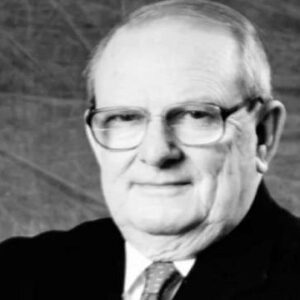South African-American physicist Allan McLeod Cormack was awarded the 1979 Nobel Prize in Physiology or Medicine. Though his primary research focus was nuclear physics and particle physics, his contributions to X-ray computed tomography were notable. After obtaining his bachelor’s and master’s degrees in physics and crystallography, he began conducting research at St. John’s College, Cambridge. Between 1950 to 1956, he taught at the University of Cape Town before spending a sabbatical year conducting research at Harvard University. In 1957, he began his employment at Tufts University. Throughout his career, he remained at the institution and also served as Chairman of the Physics Department from 1968 to 1976. In the 1960s, he devised a mathematical formula that enabled the creation of an exact image based on measurements of X-rays traveling through the body from different directions. The 1979 Nobel Prize in Physiology or Medicine was awarded jointly to Allan M. Cormack and Sir Godfrey Newbold Hounasfield “for the development of computer-assisted tomography” despite the fact that they did their research independently. He was one of the few recipients of the Nobel Prize in Physiology or Medicine who did not hold a doctorate in medicine or any scientific discipline.
Childhood & Adolescence
Allan McLeod Cormack was born in Johannesburg, South Africa on February 23, 1924. His father was an engineer, George Cormack, and his mother was a teacher, Amelia MacLeod Cormack. He had two older brothers and sisters.
Following the death of his father in 1936, he and his family relocated to Cape Town. He attended Cape Town’s Rondebosch Boys’ High School.
In addition to his schoolwork, he enjoyed playing tennis, acting, and debating. His interest in astronomy was influenced by the works of Sir Arthur Eddington and Sir James Jeans.
Later, he enrolled in the University of Cape Town’s Electrical Engineering program. A few years later, he changed his focus to physics. The University of Cape Town awarded him a Bachelor of Science in physics in 1944 and a Master of Science in crystallography in 1945.
Allan Cormack’s Career
After completing his postgraduate studies, he became a research student at St. John’s College in Cambridge. He studied Helium-6 in the Cavendish Laboratory under the direction of Professor Otto Frisch.
In 1950, he moved to Cape Town to become a lecturer in the physics department at the University of Cape Town. There were relatively few nuclear physicists in Cape Town, and he was mentored by the head of the physics department, Professor R. W. James, who helped him develop insights and write papers on the subject.
Between 1956 and 1957, he spent his sabbatical at the Harvard cyclotron conducting work on nucleon-nucleon scattering with professors Norman Ransey and Richard Wilson. During this leave, he was offered a professorship at Tufts University in 1957, which he accepted.
In the early 1960s, Allan M. Cormack described a method for determining the features of flat sections of soft tissues by measuring the diminished intensity of X-rays passing through different angles.
Thus, he presented the mathematical procedure for the computerized axial tomography (CAT) scan. Using data recorded by rotating electronic detectors and X-Ray, the CAT scan was applied to generate a clear map of the tissues within the body’s cross-section by applying a cross-sectional cross-section.
The findings of his continuous research and work in particle and nuclear physics were published between 1963 and 1964. In addition, he conducted CT-scanning-related research for a brief periodștiiștiiștiiștiiștiiștiiștiiștiiștiiștiiștiiștiiștiiștiiștiiștiiștiiștiiștiiștiiștii From 1968 until 1976, he served as Chairman of the Department of Physics at Tufts University.
From 1970-to 1972, he became aware of the advancements and advancements made in the CT-scanning sector, and he has since devoted time to comprehending the innovations and addressing related concerns.
His Significant Works
Allan M. Cormack was a scientist who focused his research mostly on nuclear and particle physics. His contributions to the creation of the diagnostic technology computerized axial tomography were notable.
Awards and Accomplishments
He shared the 1979 Nobel Prize in Medicine with the English electrical engineer Sir Godfrey N. Hounsfield.
In 1990, he was awarded the National Medal of Science by the U.S. president.
He was a member of the International Academy of Science, the American Academy of Arts and Sciences, the National Academy of Sciences, and the American Physical Society.
Personal History and Legacies
Allan M. Cormack married Barbara Jeanne Seavey on January 6, 1950. Three children were born to the couple: Margaret Cormack, Jean Cormack, and Robert Cormack.
Born a South African citizen, he became a naturalized citizen of the United States in 1966.
He died of cancer on May 7, 1998, in Massachusetts, United States. He was 74 years old when he passed away.
Estimated Net worth
Unknown.


